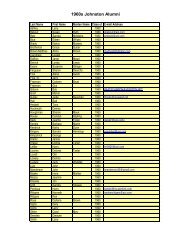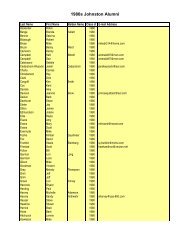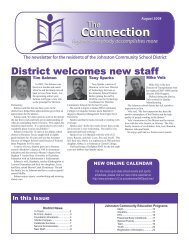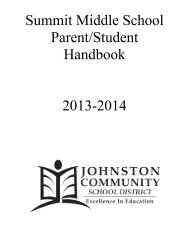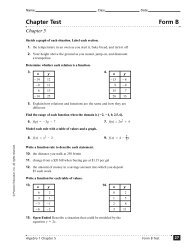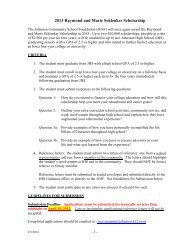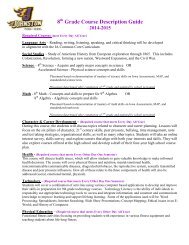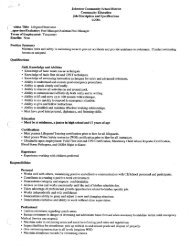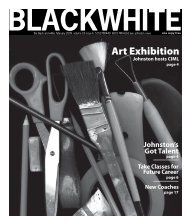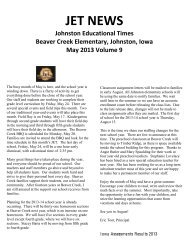Literacy Strategies for Gifted Learners
Literacy Strategies for Gifted Learners
Literacy Strategies for Gifted Learners
Create successful ePaper yourself
Turn your PDF publications into a flip-book with our unique Google optimized e-Paper software.
<strong>Literacy</strong><br />
<strong>Strategies</strong> <strong>for</strong><br />
<strong>Gifted</strong> <strong>Learners</strong><br />
Chris Bergman<br />
Annie Orsini<br />
October 11, 2010
Characteristics<br />
& Needs of<br />
<strong>Gifted</strong> Readers
Characteristics of<br />
Talented Readers<br />
• Read earlier than their peers<br />
• Spend more time reading<br />
• Read a greater variety of literature, even into adulthood<br />
(Collins & Kortner, 1995; Halsted, 1990)<br />
• Read at least two grade levels above their chronological<br />
grade placement<br />
• Demonstrate advanced understanding of language<br />
• Have an expansive vocabulary<br />
• Perceive relationships between and among characters<br />
• Grasp complex ideas (Catron & Wingenbach, 1986;<br />
Dooley, 1993; Levande, 1999)<br />
from “Schoolwide Enrichment Model-Reading”
<strong>Gifted</strong> & Talented Readers:<br />
Myths & Truths<br />
• Myth: <strong>Gifted</strong> and talented readers as a group are<br />
homogenous and should receive the same<br />
reading instruction.<br />
• Myth: <strong>Gifted</strong> and talented readers are experts at<br />
text comprehension.<br />
• Myth: <strong>Gifted</strong> and talented readers should be<br />
given complete control over their choice of<br />
reading materials.<br />
from “Reading Instruction with <strong>Gifted</strong> and Talented Readers” by Patricia F. Wood, <strong>Gifted</strong> Child Today (Summer 2008)
<strong>Strategies</strong><br />
• Compacting the regular curriculum<br />
• Acceleration of content and/or text<br />
• Inquiry reading & independent study opportunities<br />
• Use of more advanced trade books<br />
• Independent reading and writing choices<br />
• Focus on developing higher level comprehension skills,<br />
along with higher level questioning<br />
• Opportunities <strong>for</strong> book discussions – critical reading &<br />
creative reading<br />
• Use of technology and the web<br />
Adapted from “Reading Instruction with <strong>Gifted</strong> and Talented Readers” by Patricia F. Wood, <strong>Gifted</strong> Child Today<br />
(Summer 2008) & “Schoolwide Enrichment Model-Reading”
Choosing<br />
Challenging<br />
Books
• Children’s Literature Blogs (“Kidlitosphere”)<br />
• Choices Booklists from International<br />
Reading Association<br />
– http://www.reading.org/Resources/Book<br />
lists.aspx<br />
• Carol Hurst’s Children Literature Site<br />
– www.carolhurst.com<br />
• Click on “Subjects” or “Curriculum<br />
Areas” <strong>for</strong> books related to specific<br />
themes.<br />
• The kids!
Writing
Questioning
Heart Wonder Photo:<br />
http://3.bp.blogspot.com/_x9TUFDuDl6k/S9ZBAlF8KMI/AAAAAAAAA4k/GTiG29ZNGrk/s1600/DSC00936.JPG<br />
Wonder Walk: http://creativeliteracy.blogspot.com/2010/04/second-grade-wonder-walk.html
“The way a book is read –<br />
which is to say, the<br />
qualities a reader<br />
brings to a book – can<br />
have as much to do with<br />
its worth as anything<br />
the author puts into it.”<br />
~Norman Cousins,<br />
editor and writer
Book Clubs & Response
Thinking about Perspective,<br />
Imagination, & More
21 st Century Learning
• Online Stories & Digital Storytelling:<br />
– http://www.read.gov/exquisite-corpse/<br />
• Plain English Video:<br />
http://www.commoncraft.com/video-wikisplain-english<br />
• Examples of Educational Wikis:<br />
http://educationalwikis.wikispaces.com/Ex<br />
amples+of+educational+wikis<br />
• Kidblog.org<br />
• Allaboutexplorers.com
Enhancing Social-Emotional<br />
Development
• recognizing and owning giftedness<br />
• expectations vs. per<strong>for</strong>mance<br />
• taking risks<br />
• others’ expectations vs. own needs
• coping with need <strong>for</strong> clear-cut answers<br />
• meeting their inner demand <strong>for</strong> an identity<br />
• avoiding the temptation to make<br />
premature decisions
• establishing an identity<br />
• needing time alone<br />
• engaging in relationships with others<br />
• learning how to use one’s ability
• <strong>for</strong> the ability to be developed and used<br />
• <strong>for</strong> the child possessing it to become<br />
creative<br />
• to be able to produce something of value<br />
to himself or herself
• <strong>for</strong> the ability to be developed and used<br />
• <strong>for</strong> the child possessing it to become<br />
creative<br />
• to be able to produce something of value<br />
to himself or herself
Challenging Verbal Abilities<br />
• Vocabulary<br />
• Read, read, read<br />
• Read variety of literary conventions and<br />
styles and that use language gracefully<br />
• Express ideas
• Fiction touches the emotions<br />
• Fictional characters and situations<br />
support emotional release<br />
• Fiction allows the reader to gain insights<br />
into his or her own situation
Content Bibliography<br />
• Some of My Best Friends Are Books: Guiding <strong>Gifted</strong> Readers from<br />
Preschool to High School by Judith Wynn Halsted<br />
• Literature Links: Activities <strong>for</strong> <strong>Gifted</strong> Readers by Teresa Smith<br />
Maiello<br />
• Autonomous Learner Model: Optimizing Ability by George Betts &<br />
Jolene Kurcher<br />
• Recognizing <strong>Gifted</strong> Potential: Planned Experiences with the KOI by<br />
Bertie Kingore<br />
• Differentiation: Simplified, Realistic, and Effective by Bertie Kingore<br />
• Nonfiction Mentor Texts: Teaching In<strong>for</strong>mational Writing Through<br />
Children’s Literature,K-8 by Lynne Dorfman & Rose Cappelli<br />
• The Reviser’s Toolbox by Barry Lane<br />
• But How Do You Teach Writing by Barry Lane<br />
• Make It Real by Linda Hoyt<br />
• Snapshots by Linda Hoyt
Content Bibliography<br />
• Reading with Meaning by Debbie Miller<br />
• Comprehension Connections: Bridges to Strategic Reading by<br />
Tanny McGregor<br />
• <strong>Strategies</strong> that Work: Teaching Comprehension <strong>for</strong> Understanding<br />
and Engagment by Stephanie Harvey & Anne Goudvis<br />
• Comprehension & Collaboration: Inquiry Circles in Action by<br />
Stephanie Harvey & Harvey Daniels<br />
• Mosaic of Thought: The Power of Comprehension Strategy<br />
Instruction by Susan Zimmerman & Ellin Oliver Keene<br />
• Websites Used:<br />
– http://www.gifted.uconn.edu/SEMR<br />
– http://www.bertiekingore.com<br />
– http://www.choiceliteracy.com



